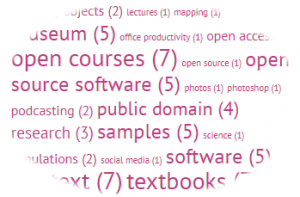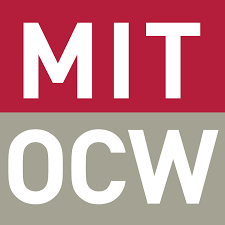
Types of OER include full courses, course materials, modules, learning objects, open textbooks, openly licensed (often streamed) videos, tests, interactive multimedia elements, software, and other tools, materials, or techniques used to support teaching and learning. Any content that is available to use for teaching and learning, that has an open license, can be considered OER.
OER may be static resources, or even dynamic resources that adapt in real time while content contributors interact with and updating them. OER can even be an entire module, course, or textbook made up of a combination of other OER resources.
Specifically regarding courses and textbooks, it is worth exploring Open Courseware and Open Textbooks as you consider OER for adoption.
OpenCourseWare

OpenCourseWare are course lessons created at universities and published under an open license. The OpenCourseWare movement started in 1999 when the University of Tübingen in Germany published videos of lectures online for its timms initiative (Tübinger Internet Multimedia Server). The OCW movement took off in the United States with the launch of MIT OpenCourseWare at the Massachusetts Institute of Technology (MIT) in October, 2002.
EXPLORE MORE ABOUT MIT OPENCOURSEWARE
The movement was soon reinforced by the launch of similar projects at Yale University, the University of Michigan, and the University of California Berkeley. MIT’s reasoning behind OpenCourseWare was to “enhance human learning worldwide by the availability of a web of knowledge.”
Open Textbooks

Photo by Sharon McCutcheon on Unsplash
Open textbooks refer to textbooks licensed under an open copyright license, and made available online to be freely used by students, teachers and members of the public. Many open textbooks are distributed in either print, e-book, or audio formats that may be downloaded or purchased at little or no cost. Open textbooks either reside in the public domain or are released under an open license that grants usage rights to the public so long as the author is attributed.
Part of the broader open educational resources movement, open textbooks increasingly are seen as a solution to challenges with traditionally published textbooks, such as access and affordability concerns. Open textbooks were identified in the New Media Consortium’s 2010 Horizon Report as a component of the rapidly progressing adoption of open content in higher education.
Many of these OER textbooks provide test banks (and power points, and other supplementals that you may be used to getting from a publisher). Nicole Finkbeiner of OpenStax explains how these are kept secure:
“In terms of ‘protected’ resources such as test banks, you have to find a way for students to not be able to access these. And, you don’t want to openly license these because then you have no way to combat them being published. At Rice University’s OpenStax College, our website is set up so faculty have to first register for an account and then request faculty access prior to being able to download them. We check every single account to ensure the right official email is used, they are in fact teaching a course where they would need the resources, etc. Sometimes we even call the department chair directly to make sure we should be providing access.”
It’s true that adopting open resources in place of a traditionally published textbook involves a change in how you think about your course textbook. Are you still working with a static publication with no room for content updates?
EXPLORE THE OPEN TEXTBOOK LIBRARY
With OER you don’t need to wait for the publisher to come out with a new edition in order to correct a mistake or update old information. Depending on the OER license, you may have the right to update any OER yourself or notify the author that something needs to be updated or adapted. Or you may find that other members of the community have already completed an update, and shared their adapted version for you to draw from, as well.
The content of this course is adapted from the following works:
- “Find OER” by Open Professionals Education Network, licensed under CC BY 4.0
- “OER 101” by David Rose, American University, licensed under CC BY 4.0
- “Evaluating OERs” by Duke Library at Furman University, licensed under CC BY 4.0 / A derivative from the original work
- “Adopt OER” by Open Education Consortium, licensed under CC BY 4.0
- How to attribute Creative Commons licensed Materials by National Copyright Unit, Copyright Advisory Groups (Schools and TAFEs) licensed under CC BY 4.0
- “Open Attribution Builder” by Open Washington, SBCTC licensed under CC BY 4.0
- “Types of OER” by Montgomery College, licensed under CC BY 4.0
![]() Unless otherwise noted, this work is licensed under a
Unless otherwise noted, this work is licensed under a
Creative Commons Attribution 4.0 International License.
